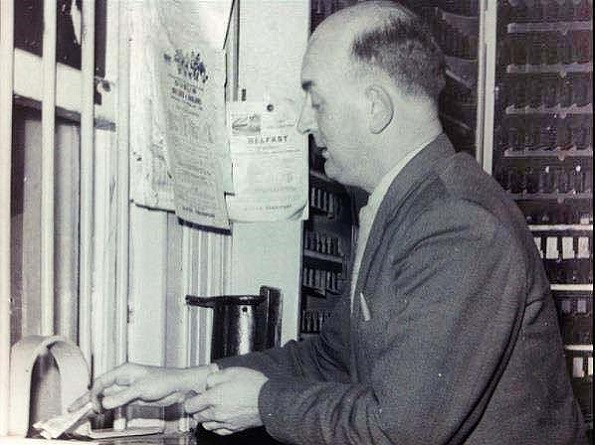 On Sunday 15 February 1965 the Strabane booking office clerk Bendon O'Hare is seen selling the very last ticket that was sold from the former GNRI station.
On Sunday 15 February 1965 the Strabane booking office clerk Bendon O'Hare is seen selling the very last ticket that was sold from the former GNRI station.
Photo by from Declan O'Hare
Strabane is an important regional centre in County Tyrone, Ireland, and lies at the point where the River Mourne and the River Finn converge to form the River Foyle. Transport links to Strabane had been improved in 1796 when a 4 mile long canal was built to connect the town directly to the navigable part of the River Foyle and thereby improve the industrial and commercial prospects of the town. The town also lies close to the border with County Donegal and the important town of Lifford.
Fourteen miles to the north of Strabane is the city of Derry/Londonderry which by the 19th Century had become an important port and industrial centre and the largest city in the North West of Ireland. Whilst the Strabane Canal and River Foyle provided a link with Derry/Londonderry by the 1830s thoughts had been given to the creation of a railway and a survey was carried out in 1837. In 1845 the Londonderry & Enniskillen Railway (L&E), which was a 60 mile long single track line of 5ft 3inch gauge (which became the Irish standard gauge) was authorised. Work commenced in October 1845 and the first section, between a temporary terminus at Londonderry Cow Market and Strabane opened to traffic on 19 April 1847.
Strabane station was to the north-west of its namesake just to the north of the Lifford Road which crossed the line by means of a level crossing. Directly to the south of the level crossing was the River Mourne over which the line was carried on an iron bridge.
The station was accessed by Railway Road which ran up to the station building. The first station building (of which no known photograph survives) was on the east side of the line and appears from the 1863 6-inch scale OS map to have been relatively substantial. There was just one platform, also on the east side of the line. As the station was the southern terminus of the line when it opened there must also have been a means of running engines around their trains, a loop being the most likely.
As Strabane was an important regional centre the station had substantial goods facilities. They were located to the east of the passenger station and were also accessed from Railway Road. The goods sidings connected to the main line to the north of the passenger station.
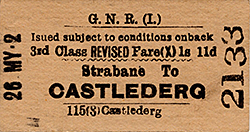 The March 1850 timetable showed four weekday departures for Londonderry Cow Market and four corresponding arrivals. On 18 April 1850 the line was extended to the permanent northern terminus of Londonderry Foyle Road nearer the City Centre. The March 1850 timetable showed four weekday departures for Londonderry Cow Market and four corresponding arrivals. On 18 April 1850 the line was extended to the permanent northern terminus of Londonderry Foyle Road nearer the City Centre.
Progress on the construction of the rest of the line was slow, with Newtonstewart not being reached until 9 May 1852. Train services started to run to and from Omagh on 13 September 1853, it having taken six years to build the 19 miles of railway from Strabane. Enniskillen was finally reached on 19 August 1854.
The L&E had struggled financially from the start and it was still struggling when on 15 February 1859 the Dundalk & Enniskillen Railway (D&ER) opened the final section of their line. In doing so a route between Ireland’s capital city, Dublin, and Derry/Londonderry had been created. It was quickly realised that the route between Dundalk and Derry/Londonderry would be better run by one company and following the granting of an Act the L&E leased their line to the D&ER for 99 years commencing 1 January 1860. On 7 July 1862 the D&ER was renamed as the Irish North Western Railway (INWR).
On 2 September 1861 the Portadown, Dungannon & Omagh Railway was opened between Omagh and Dungannon which created a through route between Belfast and Derry/Londonderry via Portadown. The section of the route between Portadown and Derry/ Londonderry would go on to become well known as the ‘Derry Road’.
Fourteen miles to the west of Strabane, located on the River Finn in County Donegal, are the twin town of Stranorlar (north bank of the river) and Ballybofey (south bank of the river). The two largest landowners of the area were the 4th Viscount Lifford and Sir Samuel Hayes, Bart. They realised that a railway between Stranorlar and Strabane following the course of the River Finn would bring many benefits and in 1859 they formed the Finn Valley Railway Company (FVR). On 15 May 1860 they obtained an act to build a 14 mile long line between Strabane and Stranorlar. The line was built to the Irish standard gauge (5ft 3inch) which was the same as the L&ER line. An agreement was reached that allowed the FVR to use the existing Strabane station as their eastern terminus. A connection was made with the L&ER line 30 chains to the south of Strabane station at what became Finn Valley Junction. The FVR opened on 7 September 1863 and it was also worked by the INWR.
A timetable issued just after the opening of the FVR line showed three trains in each direction on the main line and three in each direction on the branch. Through coaches operated to both Belfast and Dublin.
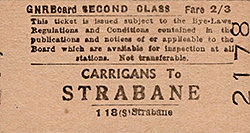 A derailment occurred at Strabane station on 5 April 1872 due to a rail not being adequately secured at some points that gave access to a siding. The accident report that was submitted on 7 May 1872 describes the station as being on a mainly single track line and having just one platform so it appears that there had been little change from 1847. The report also states that there was a watering facility at the north end of the platform. No mention is made of any loop at the station but, as with the situation in 1847, trains terminated at Strabane (this time from the south off the FVR) and their engines would have had to run around. A derailment occurred at Strabane station on 5 April 1872 due to a rail not being adequately secured at some points that gave access to a siding. The accident report that was submitted on 7 May 1872 describes the station as being on a mainly single track line and having just one platform so it appears that there had been little change from 1847. The report also states that there was a watering facility at the north end of the platform. No mention is made of any loop at the station but, as with the situation in 1847, trains terminated at Strabane (this time from the south off the FVR) and their engines would have had to run around.
The FVR company was not entirely happy with the financial arrangements that it had with the INWR and from 1 November 1872 it entered into a new agreement in which it provided its own coaches for the Strabane and Stranorlar branch and the INWR provided the motive power.
On 1 January 1876 agreement was reached for the INWR to be taken over by the Northern Railway (Ireland) and in turn that company merged with the Ulster Railway to form the Great Northern Railway Ireland (GNRI) on 1 April 1876. Despite this the L&E remained a separate company until it was finally bought out by the GNRI in 1883.
The GNRI made improvements to Strabane station. In 1882 they replaced the original station passenger facilities with a single-storey brick building under a pitched slate roof with segmental arch openings. Flat awning with deep valancing. A single-storey hipped roofed extension at one end of the main building.
A second platform was also added. This new platform was in the form of an island with two faces. The eastern face served the down main line and the western face served a down loop. The purpose of this third platform face might have been to serve the FVR trains. To control the expanded layout a signal cabin was opened on the north side of the Lifford Road level crossing and on the west side of the line.
In 1892 the FVR merged with the West Donegal Railway (WDR) to form the Donegal Railway (DR). The former WDR lines were all 3ft gauge and they extended to Stranorlar. Transhipment was therefore required at that point. Even before the merger thoughts had been given to converting the FVR route to 3ft gauge and in 1893 authority to do so was granted. Within the same act that allowed for the gauge conversion authority was also given for the creation of a section of new line and a new station at Strabane. The FVR had never been completely happy with the arrangements that it had for using the GNRI station which also came at a cost. As the line was being converted to 3ft gauge it made sense for the DR to build their own station. The new station was located just to the west of the GNRI facility. It opened on 16 July 1894 and Finn Valley Junction closed and was removed. A covered footbridge (at the south end of both stations) was provided to link the two stations. It was little used by passengers though, who preferred to cross the tracks via a barrow crossing.
Extensive transhipment facilities were gradually developed to the north of both stations on the west side of the GNRI line. A new signal cabin was opened at the north end of the up platform in 1895. This controlled access to the transhipment sidings as well as the main line going north. The new cabin was given the name Strabane North Cabin and the 1882 cabin became Strabane South Cabin.
The December 1895 timetable showed eight up and nine down services Monday-to-Saturday. There was just one train in each direction on Sundays.
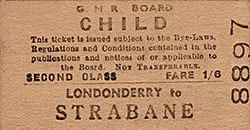 On 1 August 1900 the DR opened a 3ft gauge line between their Strabane station and the city of Derry/Londonderry to goods, with passenger services starting on 6 August 1900. The GNRI had objected to this development as they saw in it a threat to their profits. The line however took a course that ran south of the River Foyle through County Tyrone and County Londonderry. It terminated at a station in the Waterside area called Londonderry Victoria Road. On 1 August 1900 the DR opened a 3ft gauge line between their Strabane station and the city of Derry/Londonderry to goods, with passenger services starting on 6 August 1900. The GNRI had objected to this development as they saw in it a threat to their profits. The line however took a course that ran south of the River Foyle through County Tyrone and County Londonderry. It terminated at a station in the Waterside area called Londonderry Victoria Road.
The 1904 Handbook of Stations listed Strabane GNRI station as being able to handle general goods, parcels, furniture vans, and livestock. The station was also equipped with a 2-ton lifting crane. The 25-inch scale OS map of 1905 shows a large two-road goods shed with loading platforms, four other sidings, cattle pens with a loading ramp and a weighing machine. In addition to the north of the passenger station on the west side of the line the map shows the large transhipment shed which was used to transfer goods between the DR and the GNRI.
In 1903 the Midland Railway (MR), an English company, absorbed the network of the Belfast & Northern Counties Railway. They operated their Irish lines as the MR Northern Counties Committee (NCC). The MR had aspirations for expansion in Ireland and they looked to purchase the DR system. This alarmed the GNRI who objected strongly. In the end, though, a compromise was reached whereby the GNRI and the MR would take over the DR. They did so on 1 May 1906 through the formation of the County Donegal Railway Joint Committee (CDR). The 3ft line between Strabane and Londonderry Victoria Road was excluded from the joint company and passed wholly to the MR NCC but the train services were operated by the CDR. These developments meant that the GNRI now owned half of the former DR station. It was decided that it would make sense to run both of the stations as a single entity joint station. The Strabane station staff were provided with a specific uniform that was badged with the logos of all 3 railway companies.
During 1911 the GNRI rebuilt and strengthened the River Mourne bridge so that it could take heavy locomotives. The works necessitated a realigning of the line which resulted in the Strabane South Cabin having to be replaced with a new structure that was positioned on the east side of the line.
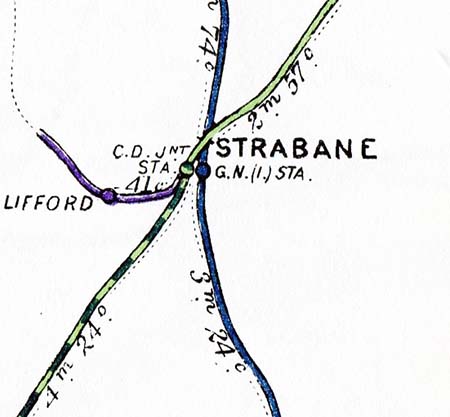 On 4 August 1914 the British Empire declared war on Germany and entered the Great War. From 1 January 1917 the GNRI was taken into British Government control (along with all of the other Irish railways). The GNRI system was used intensely during the war years. Almost as soon as the fighting had stopped on 11 November 1918 the Irish War of Independence broke out in January 1919. In early 1921 the government relinquished control of the CDR and it was put back into the hands of its directors. The line’s problems had not gone away however as by the end of 1921 Ireland was partitioned into two separate countries. The GNRI now found itself operating in two separate countries with all of the administrative difficulties that brought. County Tyrone became part of Northern Ireland and County Donegal became part of The Irish Free State. To the north of Strabane railway station the GNRI line crossed the River Foyle into County Donegal and therefore it entered into another country. Then just north of Carrigans station it re-entered Northern Ireland. This meant two international border crossings within 15 miles. On 4 August 1914 the British Empire declared war on Germany and entered the Great War. From 1 January 1917 the GNRI was taken into British Government control (along with all of the other Irish railways). The GNRI system was used intensely during the war years. Almost as soon as the fighting had stopped on 11 November 1918 the Irish War of Independence broke out in January 1919. In early 1921 the government relinquished control of the CDR and it was put back into the hands of its directors. The line’s problems had not gone away however as by the end of 1921 Ireland was partitioned into two separate countries. The GNRI now found itself operating in two separate countries with all of the administrative difficulties that brought. County Tyrone became part of Northern Ireland and County Donegal became part of The Irish Free State. To the north of Strabane railway station the GNRI line crossed the River Foyle into County Donegal and therefore it entered into another country. Then just north of Carrigans station it re-entered Northern Ireland. This meant two international border crossings within 15 miles.
As if this wasn’t bad enough a Civil War broke out in The Irish Free State in June 1922. This caused further disruption to the railway and went on until May 1923.
In 1923 the MR was merged into the London, Midland & Scottish Railway (LMS) and they became the GNRI’s partner in the running of Strabane station (having taken the MRs half share in the CDR), now under the control of the LMS NCC.
In order to get around the problem of the two international borders between Strabane and Londonderry Foyle Road most trains ran non-stop over that section of line. They were also locked and sealed so that passengers could not board or detrain. Only local stopping services served the 3 intermediate stations to the north of Strabane and they were subject to customs checks.
The 1920s and 1930s were a difficult period for the GNRI as they were marred by industrial unrest and there was increasing competition from road transport.
During the Second World War (1939 – 1945) the ‘Derry Road’ was not as busy as it might have been. Derry/Londonderry became an important military and industrial centre but because the line between that city and Strabane ran through the Irish Free State, which was a neutral country, war materials could not use the ‘Derry Road’. Thoughts were given to converting the Strabane to Londonderry Victoria Road 3ft gauge route to the 5 foot 3 gauge but in the end it proved to be too difficult and the idea was dropped. Strabane station however was busy during the war as food products were brought in from the Irish Free State via the GNRI and CDR networks.
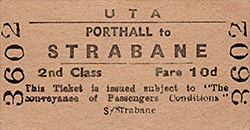 After the Second World War the Northern Ireland government decided to create a single integrated transport authority and through the Transport Act (NI) which was passed on 10 August 1948 the Ulster Transport Authority (UTA) was created. By 1 April 1949 it had taken over all of the railways within Northern Ireland including the LMS NCC with the exception of the GNRI. As the GNRI operated in two countries it was left out of the Act. After the Second World War the Northern Ireland government decided to create a single integrated transport authority and through the Transport Act (NI) which was passed on 10 August 1948 the Ulster Transport Authority (UTA) was created. By 1 April 1949 it had taken over all of the railways within Northern Ireland including the LMS NCC with the exception of the GNRI. As the GNRI operated in two countries it was left out of the Act.
The Irish Free State became the Republic of Ireland in 1948 and they nationalised their railways (which had already been grouped), with the exception of the GNRI, as the Córas Iompair Éireann (CIE) in 1945.
These developments did not directly affect the way railway services operated at Strabane and even the CDR remained intact as a company (but with new owning partners).
In 1948 the GNRI had ordered twenty diesel railcars from AEC Ltd. They started to operate on services through Strabane in 1951, operating on the 2.10pm Belfast Great Victoria Street to Londonderry Foyle Road and the 6.40pm Londonderry Foyle Road to Belfast Great Victoria Street services.
By 1953 the GNRI was in serious financial trouble and the two governments of the island of Ireland had to step in. The solution that was found was to create a new body, the Great Northern Railway Board (GNRB) which was run by ten members, five from the Republic of Ireland and Five from Northern Ireland. The new ‘Board’ took over on 1 September 1953.
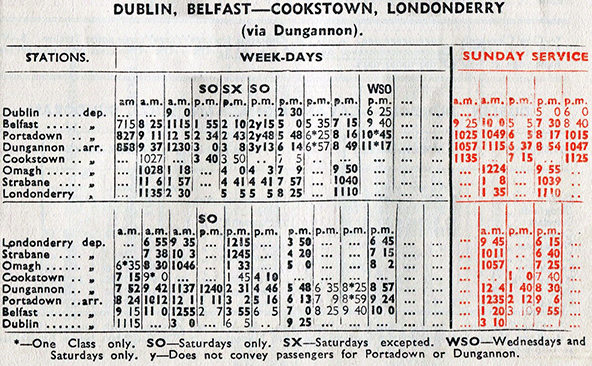
The summer timetable published on 27 June 1954 (extract shown above) showed eight up services Monday-to-Friday. The first up departure was at 7.28 and it was a service for Belfast Great Victoria Street and Dundalk with the train splitting at Omagh. In all there were five through trains to Belfast Great Victoria Street, three of which had a restaurant car service. On Saturdays there was an extra up working that departed from Strabane at 11.41pm and ran to Victoria Bridge. There were ten down services Monday-to Saturday all of which ran to Londonderry Foyle Road. On Sundays there were two up and three down trains.
The GNRB invested £528,000 in more diesel railcars, which directly benefited Strabane as they would be put into service on the Belfast – Derry/Londonderry services. Despite the savings from the new railcars the GNRB continued to make losses. The Northern Ireland government was not of a mind to sustain them and economies started to be made. In 1956 they announced that there would be closures which included the route between Omagh and Enniskillen (part of the original route of the L&E).
On 1 October 1957 Strabane lost its services to Enniskillen and in the same year the Northern Ireland government announced that it was going to end the agreement with the Irish Government that had created the GNRB.
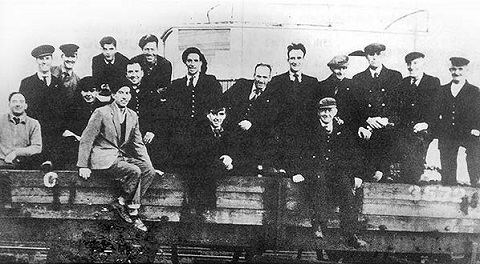 In the summer months of 1958, an experimental through working between Londonderry Foyle Road and Dublin Amiens Street (Dublin Connolly after 1966) was introduced. The up service departed from Strabane at 4.20pm and arrived at Dublin at 8.15pm. The service was not continued with in 1959. In the summer months of 1958, an experimental through working between Londonderry Foyle Road and Dublin Amiens Street (Dublin Connolly after 1966) was introduced. The up service departed from Strabane at 4.20pm and arrived at Dublin at 8.15pm. The service was not continued with in 1959.
At midnight on 30 September 1958 the GRNI ceased to exist when the ‘Board’ was wound up and the assets of the company were divided between the UTA of Northern Ireland and the CIE of The Republic of Ireland. Strabane was affected by the change when the UTA withdrew one train in each direction of the through Belfast – Derry/Londonderry services.
On 1 January 1960 the CDR station, along with what remained of the erstwhile Donegal Railway (there had been contraction of that system since 1947, including the closure of the route to Londonderry Victoria Road on 1 January 1955) was closed to passengers and the last freight trains ran a month later. Buses replaced those trains and they still operated to the railway station and so it continued to be an important interchange point. An American Millionaire, Dr Ralph Cox had become interested in the CDR when he visited Ireland on holiday in 1959. He purchased four steam engines, three railcars, ten coaches, twenty covered wagons, twenty wagon chassis and infrastructure items such as rails and fastenings with a view to moving it all to the USA. The rolling stock was moved to the Strabane CDR station to await collection after the auction in March 1961.
On 16 September 1961 Hurricane Debbie hit the north-west coast of Ireland. The hurricane struck with a ferocity not previously experienced with gusts reaching 90mph. Extensive damage was done to the ‘Derry Road’ and at Strabane station the footbridge roof was blown off. Train services were severely disrupted and it took several weeks to fix all of the damage. The footbridge roof was not replaced.
On 17 July 1963 The Benson Report was published. It had been commissioned by the Northern Ireland government to see what could be done to make the already much reduced remaining railway network profitable. The Benson Report recommended further contraction including complete closure of the ‘Derry Road’ route. The County Councils whose areas were served by the line, including Tyrone County Council, were not happy with its findings and they made legal representations to no avail.
In 1963 Strabane still had four services to Belfast Great Victoria Street and four to Londonderry Foyle Road. There was also a train in each direction between Strabane and Londonderry Foyle Road (usually worked by railcar A). There was also still a healthy traffic in goods from Strabane. There were two goods trains per day each way between Strabane and Belfast and there was a trip working to Derry/Londonderry.
Tyrone County Council attempted to win a reprieve for the line and even resorted to High Court action (taking the government to court twice). Their efforts were not successful as the Stormont Government was notoriously anti-rail. The actions only bought a little more time and eventually a closure date of 14 February 1965 was set.
The UTA withdrew internal goods services (within Northern Ireland) on 4 January 1965 which was the initial proposed date for full closure delayed by the High Court action. Freight services to CIE and CDR stations continued until Saturday 13 February 1965.
On Sunday 14 February 1965 the last passenger services ran from Strabane. The last up train (for Belfast Great Victoria Street) departed at 7.00pm and the last down (for Londonderry Foyle Road) left at 10.45pm.
Trains were operated after closure to collect rolling stock that was scattered along the length of the line. The last of these trains departed from Strabane on Wednesday 17 February 1965.
The final rail movements at Strabane occurred in the early months of 1966 when track lifting operations took place. Interestingly whilst the main line was lifted many sidings were left in situ at Strabane and had to be lifted by road vehicles at a later date. Strabane railway station continued to be used for UTA and CDR bus services until February 1966 and both transport companies stored buses at the station site until most of the station building was damaged by fire in early 1968.
Because rolling stock from the CDR system was still present throughout that station many photographers continued to visit Strabane. Photos from the late 1960s onwards show it to have fallen into a state of total dereliction.
The site was cleared in 1989 and the last remains of the station were demolished to make way for a road scheme. |

 Home
Page
Home
Page

 Home
Page
Home
Page